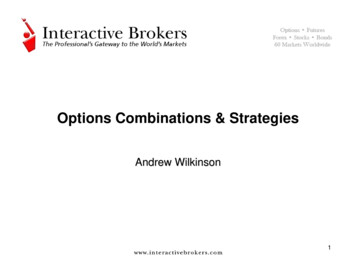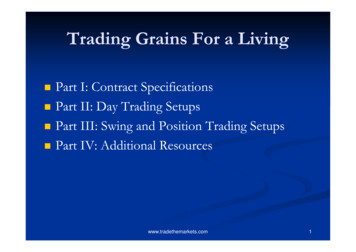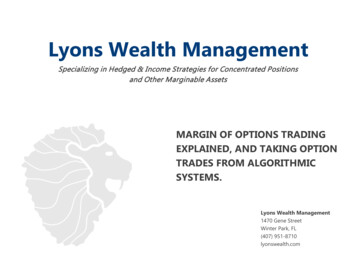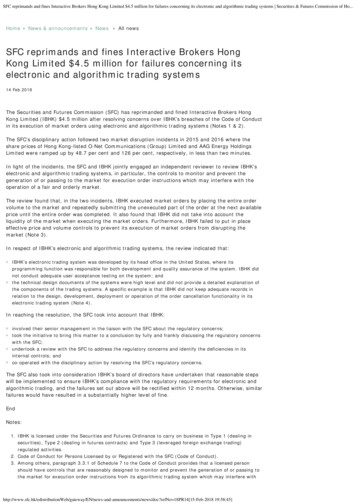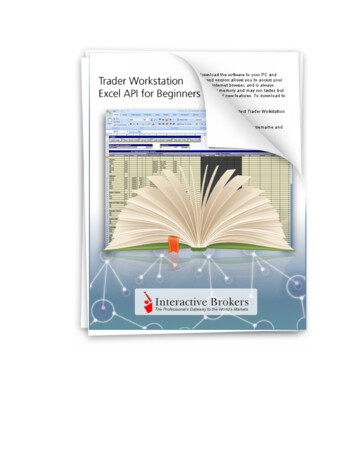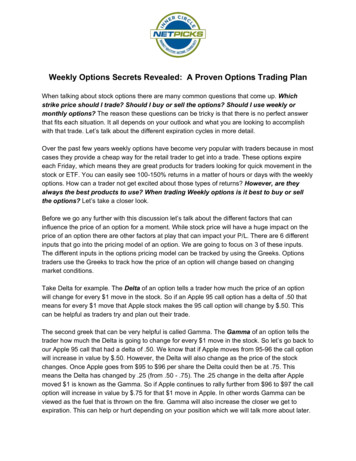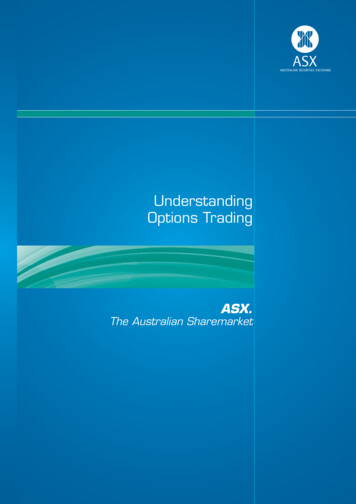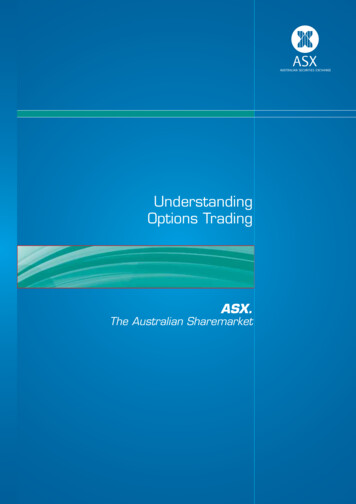
Transcription
UnderstandingOptions TradingASX.The Australian Sharemarket
Disclaimer of LiabilityInformation provided is for educational purposes and does not constitute financial product advice. Youshould obtain independent advice from an Australian financial services licensee before making any financialdecisions. Although ASX Limited ABN 98 008 624 691 and its related bodies corporate (“ASX”) hasmade every effort to ensure the accuracy of the information as at the date of publication, ASX does notgive any warranty or representation as to the accuracy, reliability or completeness of the information.To the extent permitted by law, ASX and its employees, officers and contractors shall not be liable forany loss or damage arising in any way (including by way of negligence) from or in connection with anyinformation provided or omitted or from any one acting or refraining to act in reliance on this information.No part of this Booklet may be copied, reproduced, published, stored in a retrieval system or transmittedin any form or by any means in whole or in part without the prior written permission of the ASX Group.For these product/s the market is operated by ASX Limited ACN 008 624 691.Edition 16 printed November 2011 Copyright 2011 ASX Limited ABN 98 008 624 691. All rights reserved 2011Exchange Centre, 20 Bridge Street, Sydney NSW 2000Telephone: 131 279www.asx.com.au
ContentsBefore you begin2Taxation16What is an option?3Tradeability17Call options3Put options4Advantages of option trading5Risk management5How can optionswork for you?18Time to decide5Speculation5Trading index options20Leverage5Diversification5How are index options different?20Income generation5Settlement method20Some key advantages oftrading index options21Option features6Examples of how trading indexoptions can work for you22The 5 components of an option contract61. Underlying securities/approved indices6Differences between equityoptions and index options232. Contract size63. Expiry day6Pay-off diagrams244. Exercise (or strike) price75. Premium7Call option taker24Call option writer24Put option taker25Put option writer25Summary26Risks of options trading27You and your broker28Your relationship with your broker28The paperwork: Client Agreement forms28Instructing a broker to trade options29Role of Market Makers30ASX Clear Pty Limited32Options information on the ASX web site33Glossary of terms37Option contract specifications39Further information40Adjustments to optioncontracts8Option pricing fundamentals9Intrinsic value9Call options9Put options9Time value10The role of dividends inpricing and early exercise10Parties to an option contract11The option taker11The option writer13Tracking positions and costs14How to track options positions14Costs14Margins155
Before you beginThe ASX options market has been operatingsince 1976. Since the market started, volumeshave increased significantly. There are nowover 60 different companies and the S&P ASX200 share price index to choose from. A listof companies and indices over which ExchangeTraded Options (options) are traded can befound on the ASX website, www.asx.com.au/options.This booklet explains the concepts of options,how they work and what they can be usedfor. It should be noted that this booklet dealsexclusively with Exchange Traded Options overlisted shares and indices, and not companyissued options. Information on other ASXproducts is available by calling 131 279 orvisiting www.asx.com.au. To assist in yourunderstanding there is a glossary of termson page 37.2Option sellers are referred to as ‘writers’ becausethey underwrite (or willingly accept) the obligationto deliver or accept the shares covered by anoption. Similarly, buyers are referred to as the‘takers’ of an option as they take up the right tobuy or sell a parcel of shares.Every option contract has both a taker (buyer)and a writer (seller). Options can provideprotection for a share portfolio, additionalincome or trading profits. Both the purchaseand sale of options, however, involve risk.Transactions should only be entered into byinvestors who understand the nature andextent of their rights, obligations and risks.
What is an option?An option is a contract between two partiesgiving the taker (buyer) the right, but notthe obligation, to buy or sell a securityat a predetermined price on or before apredetermined date. To acquire this right thetaker pays a premium to the writer (seller) ofthe contract.There are two types of options available:call options and put options.Call optionsCall options give the taker the right, but notthe obligation, to buy the underlying sharesat a predetermined price, on or before apredetermined date.For illustrative purposes, the term shares (orstock) is used throughout this booklet whenreferring to the underlying securities. Whenconsidering options over an index, the sameconcepts generally apply. From time to timeoptions may be available over other types ofsecurities.Call option exampleThe standard number of shares covered by oneoption contract on ASX is 100. However, thismay change due to adjustment events such asa new issue or a reorganisation of capital in theunderlying share.All of the examples in this booklet assume100 shares per contract and ignore brokerageand ASX fees. You will most definitely need toconsider these when evaluating an optiontransaction. For options over an index, thecontract value is based on a dollar value perpoint. Details can be checked in the contractspecifications.TAKER(BUYER)BROKERSantos Limited (STO) shares have a last saleprice of 14.00. An available 3 month optionwould be an STO 3 month 14.00 call. Ataker of this contract has the right, but not theobligation, to buy 100 STO shares for 14.00per share at any time until the expiry*. For thisright, the taker pays a premium (or purchaseprice) to the writer of the option. In order totake up this right to buy the STO shares at thespecified price, the taker must exercise theoption on or before expiry.On the other hand, the writer of this call optionis obliged to deliver 100 STO shares at 14.00per share if the taker exercises the option. Foraccepting this obligation the writer receives andkeeps the option premium whether the optionis exercised or not.ASXBROKERWRITER(SELLER)It is important to note that the taker is not obligatedto exercise the option.* The expiry day for stock options is usually the Thursday before the last Friday in the expiry month unless ASX Cleardetermines another day. This may change for various reasons (eg. for public holidays), so please check with your broker.For index options, refer to the contract specifications.3
Put optionsPut options give the taker the right but notthe obligation to sell the underlying sharesat a predetermined price on or before apredetermined date. The taker of a put isonly required to deliver the underlying sharesif they exercise the option.Put option exampleAn available option would be an STO 3 month 14.00 put. This gives the taker the right,but not the obligation, to sell 100 STO sharesfor 14.00 per share at any time until expiry.For this right, the taker pays a premium (orpurchase price) to the writer of the put option.In order to take up this right to sell the STOshares at a specified price the taker mustexercise the option on or before expiry. Thewriter of the put option is obliged to buy theSTO shares for 14.00 per share if the optionis exercised. As with call options, the writerof a put option receives and keeps the optionpremium whether the option is exercised or not.It is important to notethat the taker is notobligated to exercisethe option.If the call or put option is exercised, the sharesare traded at the specified price. This priceis called the exercise or strike price. The lastdate when an option can be exercised is calledexpiry day.There are two different exercise styles:American style, which means the option canbe exercised at any time prior to the expiry; andEuropean style, which means the option canonly be exercised on the expiry day. Most stockoptions traded on ASX are American style.RIGHTS AND OBLIGATIONS4CALL OPTIONTAKER(BUYER)Taker receives the right to buy shares at the exerciseprice in return for paying the premium to the writer.Writer receives and keeps premium butnow has the obligation to deliver sharesif the taker exercises.WRITER *(SELLER)PUT OPTION*TAKER(BUYER)Taker receives the right to sell shares at the exerciseprice in return for paying the premium to the writer.Writer receives and keeps premium butnow has the obligation to buy the underlying sharesif the taker exercises.* The taker of a put and writer of a call option do not have to own the underlying shares.WRITER(SELLER)
Advantages of option tradingRisk managementPut options, when taken, allow you to hedgeagainst a possible fall in the value of shares youhold.The table below compares the purchaseof 1 call option and 100 shares. Thehigher percentage return from the optiondemonstrates how leverage can work.OptionStockBought on October 15 38 400Sold on December 15 67 450Profit 29 5076.3%12.5%Time to decideBy taking a call option, the purchase pricefor the shares is locked in. This gives the calloption holder until the expiry day to decidewhether or not to exercise the option and buythe shares. Likewise the taker of a put optionhas time to decide whether or not to sellthe shares.SpeculationThe ease of trading in and out of an optionposition makes it possible to trade optionswith no intention of ever exercising them.If you expect the market to rise, you maydecide to buy call options. If you expect a fall,you may decide to buy put options.Either way you can sell the option prior toexpiry to take a profit or limit a loss.LeverageLeverage provides the potential to make ahigher return from a smaller initial outlay thaninvesting directly. However, leverage usuallyinvolves more risks than a direct investmentin the underlying shares. Trading in optionscan allow you to benefit from a change in theprice of the share without having to pay the fullprice of the share. The following example helpsillustrate how leverage can work for you.Return on investment(not annualised)DiversificationOptions can allow you to build a diversifiedportfolio for a lower initial outlay thanpurchasing shares directly.Income generationYou can earn extra income over and abovedividends by writing call options against yourshares, including shares bought using a marginlending facility. By writing an option you receivethe option premium up front. While you get tokeep the option premium, there is a possibilitythat you could be exercised against and have todeliver your shares at the exercise price.It is important that you balance the advantagesof trading options with the risks before makingany decisions. Details of the risks of optionstrading are set out on page 27.5
Option featuresThe ease of trading in and out of optionson ASX‘s options market is assisted by thestandardisation of the following option contractcomponents:1. Underlying securities2. Contract size3. Expiry day4. Exercise pricesThere is a fifth component, the optionpremium, which is not standardised butrather determined by market forces. ASXoperates the options market, while ASX ClearPty Limited (ASX Clear) operates the clearingfacility for ASX‘s options market. AmongASX‘s responsibilities is the setting of thestandardised option components.61 option contractusually represents 100underlying shares.The 5 components of an optioncontract1. Underlying securities/approved indicesOptions traded on ASX‘s options marketare only available for certain securities andapproved indices. These securities are referredto as underlying securities or underlyingshares. They must be listed on ASX and areselected by ASX Clear according to specificguidelines. The issuers of underlying securitiesdo not participate in the selection of securitiesagainst which options may be listed.Calls and puts over the same underlyingsecurity are termed classes of options.For example, all call and put options listedover Lend Lease Corporation (LLC) shares,regardless of exercise price and expiryday, form one class of option. A list of allthe classes of options trading on ASX‘soptions market can be found on the ASXwebsite www.asx.com.au/options (in the“Trading Information” section on the ‘Volatilityparameters and ETO class rankings’ page).2. Contract sizeOn ASX‘s options market an option contractsize is standardised at 100 underlying shares.That means, 1 option contract represents 100underlying shares. As mentioned earlier, thismay change if there is an adjustment such as anew issue or a reorganisation of capital in theunderlying share. In the case of index options,contract value is fixed at a certain number ofdollars per index point (for example, 10 perindex point). The size of the contract is equal tothe index level x the dollar value per index point(for example, for an index at 4,500 points, 1contract would be 4,500 x 10 45,000).3. Expiry dayOptions have a limited life span and expire onstandard expiry days set by ASX Clear. Theexpiry day is the day on which all unexercisedoptions in a particular series expire and is thelast day of trading for that particular series.For options over shares this is usually theThursday before the last Friday in the month.For index options, expiry is usually the thirdThursday of the contract month. However, ASXClear has the right to change this date shouldthe need arise.As options expire new expiry months are addedfurther out.All option classes (stock or index) have expiriesbased on the financial quarters (March, June,September and December).For example, a June expiry means that theoption expires on the expiry day in June. IfThursday or Friday are not business days, theexpiry day is brought forward.A full list of all options series available fortrading is available on the ASX website,www.asx.com.au/options in the csv file“Options code list” in the “Trading Information”section. This list is updated daily.
Traded Options (options) are traded can be found on the ASX website, www.asx.com.au/ options. This booklet explains the concepts of options, how they work and what they can be used for. It should be noted that this booklet deals exclusively with Exchange Traded Options over listed shares and indices, and not company issued options. Information on other ASX
